Elite Burials with bronze coffins found at Dabona cemetery in west Yunnan
From:Chinese Archaeology NetWriter:Date:2015-01-09
During July and November 2014, Yunnan Institute of Archaeology and Culture Relics, Dali Cultural Heritage Management Center and Xiangyun Cultural Heritage Management Center conducted a joint excavation in the Dabona cemetery located in Xiangyun county, Yunnan. Digital technology was employed to improve the resolution of recording, laying the fundamental for further study.
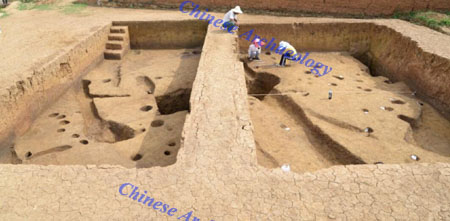
west part of the excavation area
The Dabona cemetery was first discovered in 1961 and salvage excavations were carried out in 1964, 1977 and 2008. During these excavations, bronze coffins, bronze drums and chimes of bells were recovered, indicating that the masters of these burials might have had a high social status during the Warring States period and the west Han dynasty.
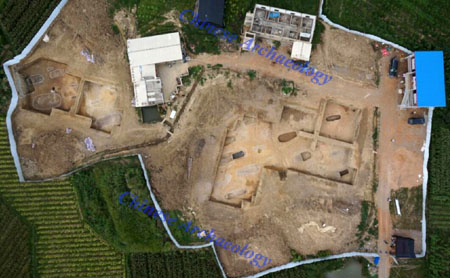
burials in the east part of the excavation area
The Dabona cemetery is composed of two parts which are 1.2 km apart from each other. A bronze coffin was found in the west part in the excavation of 1964. Earlier deposits are found covering the whole west part, which include house foundations, post holes, ash pits, ash ditches and etc.. Post holes are aligned, indicating structure of pile-dwelling. Such structure also tallied with a bronze coffin in pile-dwelling shape and pottery house model found in the tomb. In addition to the large number of pottery remains, there are also grinding stones, stone axes, bronze arrowheads and stone molds.
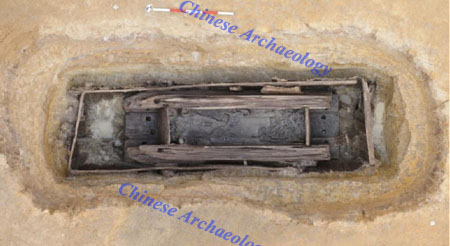
top view of burial M12
The east part could be further divided into two clusters. This excavation season largely focused on the northern cluster, covering an area of 800 square meters. There are 25 tombs found, of which 6 are large tombs whose average length is over 6m and width 2.5m. The remaining tombs are generally smaller in scale. According to the stratigraphy, they were built about the same period.

bronze axe from M12
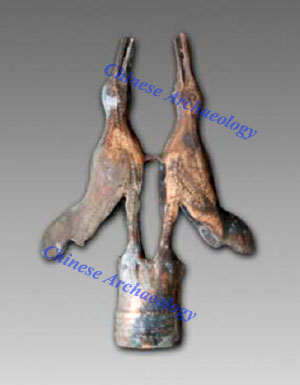
bronze ornament of cane head from M12
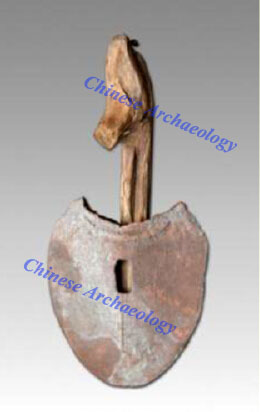
bronze hoe from burial M12
The number of archaeological assemblage is over 280, including bronze, iron, tin, stone, ceramic and wooden artefacts. Bronze wares are further categorized into weapon, productive tool, daily item and decoration. Daily goods have the largest proportion, and most of tools are hoes for cultivation. Weapon types include sword, axe, spear and arrowhead. The productive tools are shuttle shaped knives, scroll rods and peeling knives. Bracelets, decoration of cane heads and ring are common types seen in decorative accessory. The set of tin artefacts includes 4 items which were dedicatedly decorated. Only a few of iron items were found. In terms of wooden artifacts, one bow and one handle of bronze axe are preserved in good condition.

skeleton and funerary objects distributed in burial M20
Pottery remains are the most common discoveries in this excavation. There are grey-brownish pottery mixed with sands, red-brownish pottery, grey pottery and black pottery. There are very limit decorations on the pottery in spite of a few lines and scratch patterns and a small number of pottery was decorated by leaf-vein pattern at the bottom of the vessels. All pottery was hand-made and burnt in low temperature, resulting their coarse texture which makes repairing difficult. There are different types of pottery. Generally speaking, they can be classified as those with double ears, with single ear and without ear pots respectively. While those with ears were found in small numbers, deep-belly pots without ear and with wide opening mouth are abundant. Besides, ceramic cups, washbasins, plates, and weaving spindles were also found.
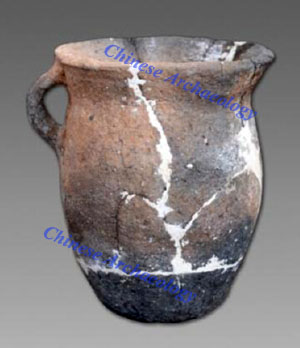
pottery pot unearthed from burial M24
The 6 large tombs excavated in this season seemed of high social ranking. It is the first discovery in Yunnan that several human skeletons were buried secondarily in the tomb where a wooden coffin was found. The living area in the west part contributes to another salient discovery. As pile-dwelling and bronze coffin in pile-dwelling shape were found at the same time, it could be speculated that people living in the pile-dwelling in this area might have shared the same ethnicity with the tomb master. Similar eagle-depicting decorations are displayed on bronze axes and bronze coffins recovered from both east and west parts, which again suggests the close connection between these two cemeteries. All these evidences point out that the Dabona site could be dated back to the Warring States period and west Han dynasty.
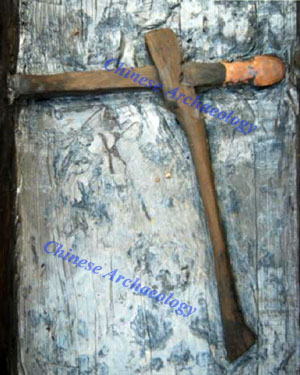
bronze axe with wood handle unearthed from burial M4
On balance, the Dabona site is an important cemetery of high social status. Though the burial style and burial goods are similar to those cemeteries around this region, it stands out as it used totally different burial furniture. The data collected during this excavation casts light upon our understanding of the Bronze culture in the Erhai region of Yunnan Province. (Translator: Dong Ningning)

